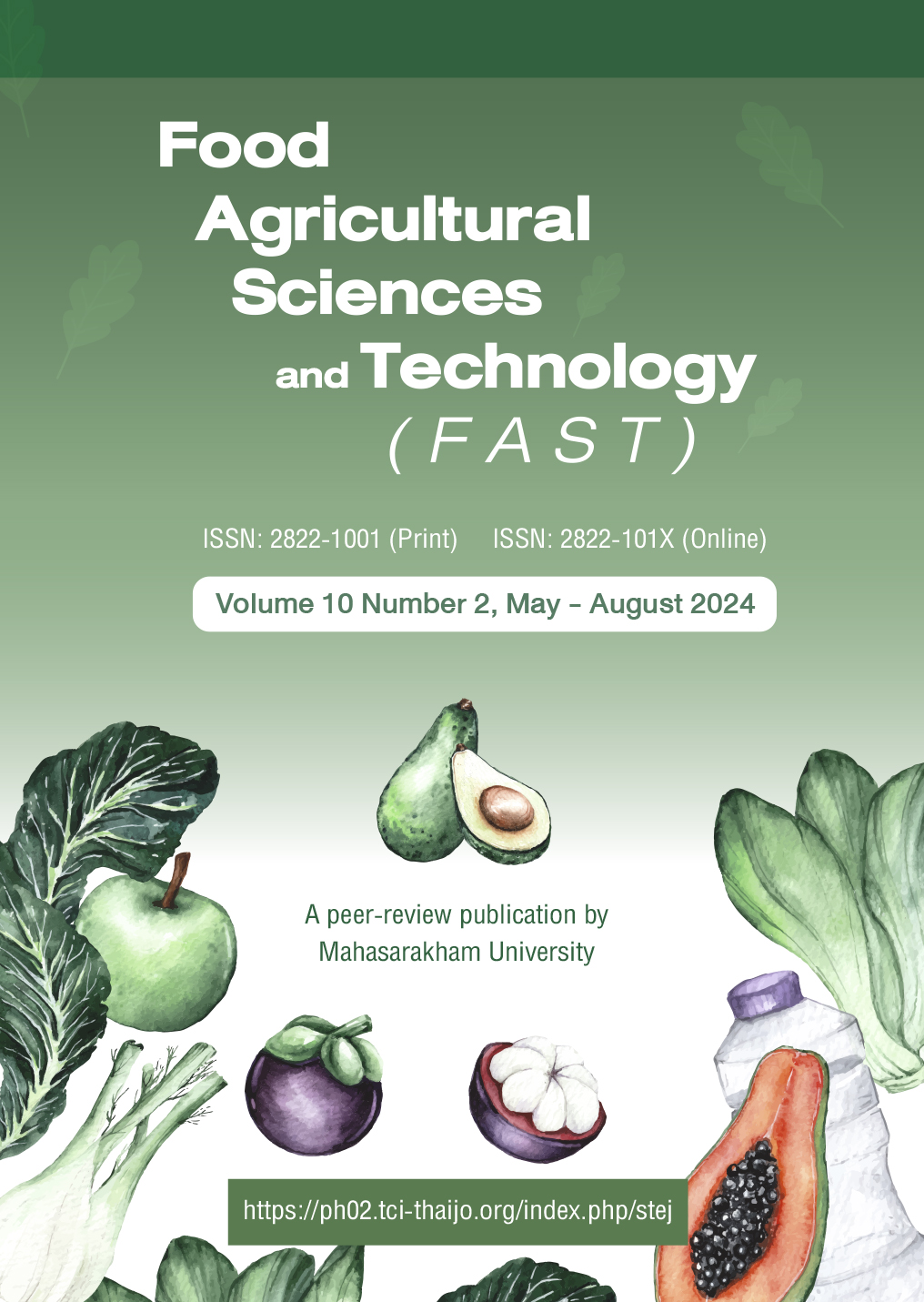Quality, textural profiles, oxidative stability and bacterial content during retail display of beef patties formulated with pectin powder
Keywords:
Pectin, Beef patties, Texture, Quality, OxidationAbstract
Pectin plays an important role in the food industry as a gelling and stabilizing agent with various bioactive compounds. This study aimed to elucidate the effects of pectin powder (PP) on the quality, texture, oxidative stability and bacterial content of beef patties during retail display. The beef Longissimus thoracis (LT) was ground and divided into 3 groups: 1) control group (0% PP), 2) ground beef supplemented with 1% PP and 3) ground beef supplemented with 2% PP. Then beef patties were made, wrapped and displayed at 4°C for 0, 3, and 6 days. Regarding the product quality, it was found that PP reduced pH and cooking loss, but on the other hand, it increased L*, a* and b* color coordinates of the beef patties (P<0.05). Regarding textural profiles, on day 6 of display, it was found that beef supplemented with 2% PP had the lowest hardness, cohesiveness, gumminess and chewiness, but the highest adhesiveness (P<0.05). However, 1% and 2% PP groups had less springiness compared to the control group (P<0.05). As for oxidative stability, groups with PP had increased antioxidant activity (P<0.05), but still, there was no significant difference in lipid oxidation among all the groups after 6 days of display (P>0.05). In addition, PP had no effect on total bacterial count during retail display (P>0.05). Therefore, from the experimental results it can be concluded that supplementing beef patties with pectin powder can improve their quality and texture by increasing color coordinates, water holding capacity, tenderness, and antioxidant activity.
References
de Moura, F. A., Macagnan, F. T., Dos Santos, L. R., Bizzani, M., de Oliveira Petkowicz, C. L., & da Silva, L. P. (2017). Characterization and physicochemical properties of pectins extracted from agroindustrial by-products. Journal of Food Science and Technology, 54(10), 3111-3117. https://doi.org/10.1007/ s13197-017-2747-9
Djordjević, J., Bošković, M., Starčević, M., Ivanović, J., Karabasil, N., Dimitrijević, M., Lazić, I. B., & Baltić, M. Ž. (2018). Survival of Salmonella spp. in minced meat packaged under vacuum and modified atmosphere. Brazilian Journal of Microbiology, 49(3), 607-613. https://doi.org/10.1016/j. bjm.2017.09.009
Gök, V., Akkaya, L., Obuz, E., & Bulut, S. (2011). Effect of ground poppy seed as a fat replacer on meat burgers. Meat Science, 89(4), 400-404. https://doi.org/10.1016/j. meatsci.2011.04.032
Gyunter, E. A., Melekhin, A. K., Popov, S. V., Durnev, E. A., Martinson, E. A., Litvinets, S. G., Konovalova, M. A., & Varlamov, V. P. (2017). Adhesive Properties of pectinchitosan composite gels. Chemistry of Natural Compounds, 53, 823-829 https://doi.org/10.1007/s10600- 017-2133-x
Hossain, M., Hoda, N., Hossen, M., Hasan, M., Mohammad, S., Rahman, S. M. E., & Kabir, S. M. L. (2015). Assessment of bacterial load of poultry meat used at dining hall of Bangladesh Agricultural University campus. Asian Journal of Medical and Biological Research, 1(1), 9-16. 10.3329/ajmbr.v1i1.25492
Honikel, K. O. (2014). Minced meats. In M. Dikeman, & C. Devine (Eds.), Encyclopedia of meat sciences (pp. 422-424). Oxford Academic Press.
Liu, S., Shi, X., Xu, L., & Yi, Y. (2016). Optimization of pectin extraction and antioxidant activities from Jerusalem artichoke. Chinese Journal of Oceanology and Limnology, 34(2), 372-381. https:// doi.org/10.1007/s00343-015-4314-4
López-Vargas, J. H., Fernández-López, J., Pérez-Álvarez, J. Á., & Viuda-Martos, M. (2014). Quality characteristics of pork burger added with albedo-fiber powder obtained from yellow passion fruit (Passiflora edulis var. flavicarpa) co-products. Meat Science, 97(2), 270-276. https://doi.org/10.1016/j. meatsci.2014.02.010
Mancini, R. A., & Hunt, M. C. (2005). Current research in meat color. Meat Science, 71(1), 100-121. https://doi.org/10.1016/j. meatsci.2005.03.003
Men’shikov, D. D., Lazareva, E. B., Popova, T. S., Shramko, L. U., Tokaev, I. S., Zalogueva, G. V., & Gaponova, I. N. (1997). Antimicrobial properties of pectins and their effects on antibiotics. Antibiotics and Chemoterapy, 42(12), 10-15.
Minzanova, S. T., Mironov, V. F., Arkhipova, D. M., Khabibullina, A. V., Mironova, L. G., Zakirova, Y. M., & Milyukov, V. A. (2018). Biological activity and pharmacological application of pectic polysaccharides: A review. Polymers, 10(12), 1407. https:// doi.org/10.3390/polym10121407
Morrissey, P. A., Sheehy, P. J., Galvin, K., Kerry, J. P., & Buckley, D. J. (1998). Lipid stability in meat and meat products. Meat Science, 49S1, S73-S86.
Mudgil, D. (2017). The interaction between insoluble and soluble fiber. In R. A. Samaan (Ed.). Dietary fiber for the prevention of cardiovascular disease. Academic Press. https:// doi.org/10.1016/B978-0-12-805130- 6.00003-3
Namir, M., Siliha, H., & Ramadan, M. F. (2015). Fiber pectin from tomato pomace: characteristics, functional properties and application in low-fat beef burger. Food Measure, 9, 305-312. https://doi.org/10.1007/ s11694-015-9236-5
Olivera, D. F., Bambicha, R., Laporte, G., Cárdenas, F. C., & Mestorino, N. (2013). Kinetics of colour and texture changes of beef during storage. Journal of Food Science and Technology, 50(4), 821-825. https://doi.org/10.1007/s13197- 012-0885-7
Parafati, L., Palmeri, R., Trippa, D., Restuccia, C., & Fallico, B. (2019). Quality maintenance of beef burger patties by direct addiction or encapsulation of a prickly pear fruit extract. Frontiers in Microbiology, 10, 1760. https://doi.org/10.3389/ fmicb.2019.01760
Pastsart, U., Sresomjit, F., Bochuai, R., & Pimpa, O. (2024). Texture profile, water holding capacity, antioxidant activity and lipid oxidation of beef during retail display from cattle fed total mixed ration supplemented with Capsicum frutescens L. and Curcuma longa L. powders. Online Journal of Animal and Feed Research, 14(1), 40-46. DOI: https:// dx.doi.org/10.51227/ojafr.2024.5
Rolin, C. (1993). Pectin. In: R. L. Whistler, & J. N. Bemiller (Eds.), Industrial gums: polysaccharides and their derivatives (pp. 257-293). Academic Press.
Selani, M. M., Margiotta, G. B., Piedade, S. M. S., Contreras-Castillo, C. J., & Canniatti-Brazaca, S. G. (2015). Physicochemical, sensory and cooking properties of low fat beef burgers with addition of fruit byproducts and canola oil. Proceedings of International Conference on Biomedical Engineering and Technology (pp. 58-65). DOI: 10.7763/IPCBEE.
Smirnov, V. V, Golovchenko, V. V, Vityazev, F. V, Patova, O. A., Selivanov, N. Y., Selivanova, O. G., & Popov, S. V. (2017). The Antioxidant properties of pectin fractions isolated from vegetables using a simulated gastric fluid. Journal of Chemistry, 2017, 589-594. https://search.emarefa. net/detail/BIM-1172087
Tarladgis, B. G., Watts, B. M., Younathan, M. T., & Dugan, L. (1960). A distillation method for the quantitative determination of malonaldehyde in rancid foods. Journal of the American Oil Chemists Society, 37(1), 44-48. https://doi.org/10.1007/BF02630824
Thakur, B. R., Singh, R. K., & Handa, A. K. (1997). Chemistry and uses of pectin--a review. Critical Reviews in Food Science and Nutrition, 37(1), 47-73. https://doi. org/10.1080/10408399709527767
Wang, L., Guo, H., Liu, X., Jiang, G., Li, C., Li, X., & Li, Y. (2019). Roles of Lentinula edodes as the pork lean meat replacer in production of the sausage. Meat Science, 156, 44-51. https://doi.org/10.1016/j. meatsci.2019.05.016
Warriss, P. D., & Brown., S. N. (1987). The relationships between initial pH, reflectance and exudation in pig muscle. Meat Science, 20(1), 65-74. https://doi.org/10.1016/0309- 1740(87)90051-9
Wathoni, N., Yuan Shan, C., Yi Shan, W., Rostinawati, T., Indradi, R. B., Pratiwi, R., & Muchtaridi, M. (2019). Characterization and antioxidant activity of pectin from Indonesian mangosteen (Garcinia mangostana L.) rind. Heliyon, 5(8), e02299. https://doi.org/10.1016/j. heliyon.2019.e02299
Xiong, Y. L. (2000). Protein oxidation and implications for muscle food quality. In Clemente J. L., Cameron F., & Eric A. D. (Eds), Antioxidants in muscle foods: Nutritional strategies to improve quality (pp. 85-111). Wiley.
Downloads
Published
How to Cite
Issue
Section
License
Copyright (c) 2024 Food Agricultural Sciences and Technology

This work is licensed under a Creative Commons Attribution-NoDerivatives 4.0 International License.







